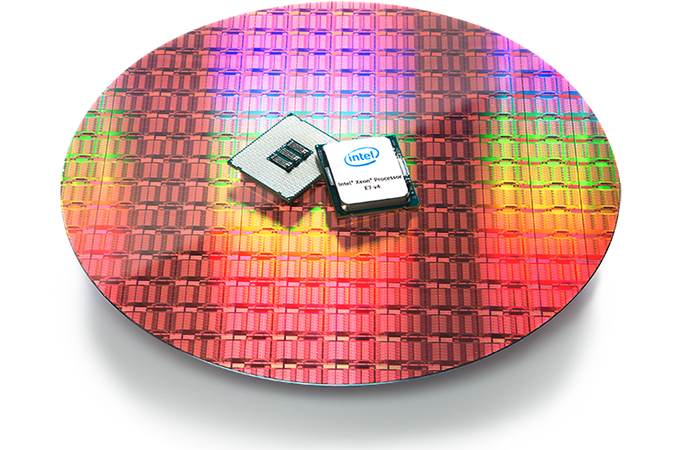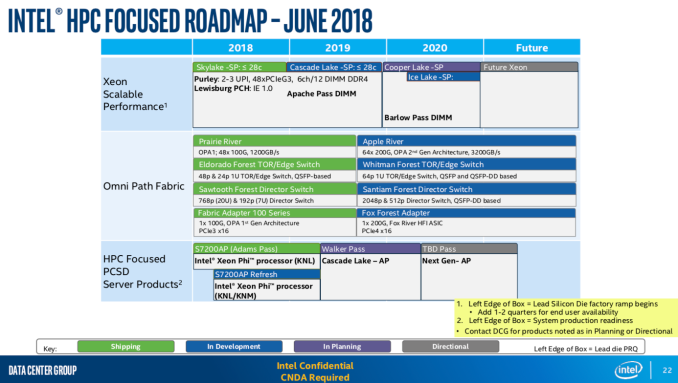Intel’s Xeon Scalable Roadmap Leaks: Cooper Lake-SP, Ice Lake-SP Due in 2020
by Anton Shilov on July 25, 2018 2:30 PM EST- Posted in
- CPUs
- Intel
- Xeon
- Enterprise CPUs
- 10nm
- Ice Lake
- Cooper Lake

Recently a Chinese university has published a collection of slide-decks from various companies covering a server/HPC event. Among the slides, Intel had a seemingly longer comprehensive presentation describing Intel’s conceptual approaches to HPC to analysis of various workloads, and most interestingly, future plans and what looks to be an up-to-date server roadmap.
According to slides published by the Central South University from Changsha City, Hunan, Intel had to delay its Ice Lake-SP server platform from 2019 to 2020 because of the general delay of its 10 nm process technology. What was unknown and newly revealed in the roadmap, is that in addition to the codenamed Ice Lake-SP processors, the company is also preparing the codenamed Cooper Lake-SP CPUs that are set to arrive a bit ahead of the Ice Lake-SP chips. The document was demonstrated to students and professors by Intel itself at a special server/HPC event earlier this month.
Both Cooper Lake-SP and Ice Lake-SP processors will support the codenamed Barlow Pass DIMMs, which is most probably Intel’s next-generation Optane DC Persistent Memory DIMM running next-gen 3D XPoint non-volatile memory (though it is a speculation at this point). Intel does not disclose the difference between the Cooper Lake-SP and the Ice Lake-SP products, but it is possible that the former is the company’s “Plan B” for next-generation servers should anything happen with its 10 nm process technology or the ICL-SP design. Meanwhile, both Cooper Lake-SP and Ice Lake-SP will belong to one server platform that will also support an eight-channel per-socket memory sub-system along with multiple OmniPath fabric innovations.
Intel expects to begin production ramp of its Cooper Lake-SP CPUs in late 2019 or early 2020 with end user availability in late Q1 2020 or mid-2020. By contrast, the Ice Lake-SP will start their ramp sometimes in late Q1 2020 and will be available in Q3 or Q4 of 2020.
Another interesting thing to point out in Intel’s roadmap is that the company is prepping the codenamed Walker Pass platform and the codenamed Cascade Lake-AP processor for the HPC market segment. The aforementioned CPU is said to replace the Xeon Phi 7200-series “Knights Landing” processor for technical computing. Meanwhile, as the name suggests, the Cascade Lake-AP will heavily rely on Skylake SP-based design for mainstream servers.
Intel traditionally does not comment on information obtained unofficially and therefore we cannot find out how accurate the current roadmap is.
Related Reading:
- Power Stamp Alliance Exposes Ice Lake Xeon Details: LGA4189 and 8-Channel Memory
- Intel’s High-End Cascade Lake CPUs to Support 3.84 TB of Memory Per Socket
- Intel Documents Point to AVX-512 Support for Cannon Lake Consumer CPUs
- Intel Begins EOL Plan for Xeon Phi 7200-Series ‘Knights Landing’ Host Processors
- Intel Shows Xeon Scalable Gold 6138P with Integrated FPGA, Shipping to Vendors
- Sizing Up Servers: Intel's Skylake-SP Xeon versus AMD's EPYC 7000 - The Server CPU Battle of the Decade?
Via: Twitter / David Shor
Source: Central South University from Changsha City, Hunan











19 Comments
View All Comments
rahvin - Wednesday, July 25, 2018 - link
Very good news for AMD, yet another delay in 10nm with cooper lake being another spin at 14nm. This pushes 10nm back another 2 years. AMD might eat their lunch by that point because that will put them almost 3 years behind the rest of the industry on process tech.Never thought I'd see the day honestly given Intel's prior track record on process tech.
HStewart - Thursday, July 26, 2018 - link
As I see most people trust Intel that used Intel - and AMD people like AMD because it not Intel.I am sure if AMD becomes a real threat to Intel's primary business - not gaming desktops, Intel will find a way to make that threat less of a threat.
I would say that Intel has been living in highlife with previous AMD lackluster changes - but that does not mean that AMD is actual threat to Intel's business.
HStewart - Wednesday, July 25, 2018 - link
I believe Intel server products ( Xeon ) typically run later than desktop/mobile products but have additional architecture functionality - for example AVX-512 was able on Xeon way before desktop and not yet available on mobile.But if this road map is correct ????, it does not mean that 10nm is delay 2020, just possibly the Server chips Xeon may possibly be delay that long.
Kevin G - Thursday, July 26, 2018 - link
AVX-512 is available on mobile if you can find a Cannon Lake part. The wide spread release of AVX-512 was mainly dependent upon their 10 nm road map being on schedule.Consumer Ice Lake is expected in 2019, roughly a year before the server parts.
The Hardcard - Wednesday, July 25, 2018 - link
Is it my aging eyes, or is Cooper Lake shaded in the purple of “in planning.” Either high-speed development or not much to do.BurntMyBacon - Thursday, July 26, 2018 - link
Sure is. Nice catch. Of course there is the possibility of misprint, but I'd lean on the side of not much to do. It is a lot easier to work out process woes and characterize a new process with a known design. They have a history (Tick-Tock) of not changing both architecture and process at the same time as well.Antony Newman - Thursday, July 26, 2018 - link
Is it pure coincidence that ‘Apple River’ with an OmniFabric @ 3.2 TB/s was planned for the same year Apple release the mMP?Any speculation out there if Apple are going to go Italian in 2019, or cook up a Gen-Z solution with home grown ARM desktop CPU and Apple AI/GPU chippery that can shunt 8K to it hearts content?
AJ
HStewart - Thursday, July 26, 2018 - link
I seriously doubt we will every see ARM on Apples desktop. Apple is only a fraction in Intel CPU business and with Raju on Intel side and his experience with both AMD GPU and before and more importantly Apple, I would not doubt we will see Intel CPU/GPU in Apple's future.Judas_g0at - Sunday, July 29, 2018 - link
Does anyone see the irony in a semiconductor company using points of local naural beauty for a naming scheme? Google "Intel superfund sites".